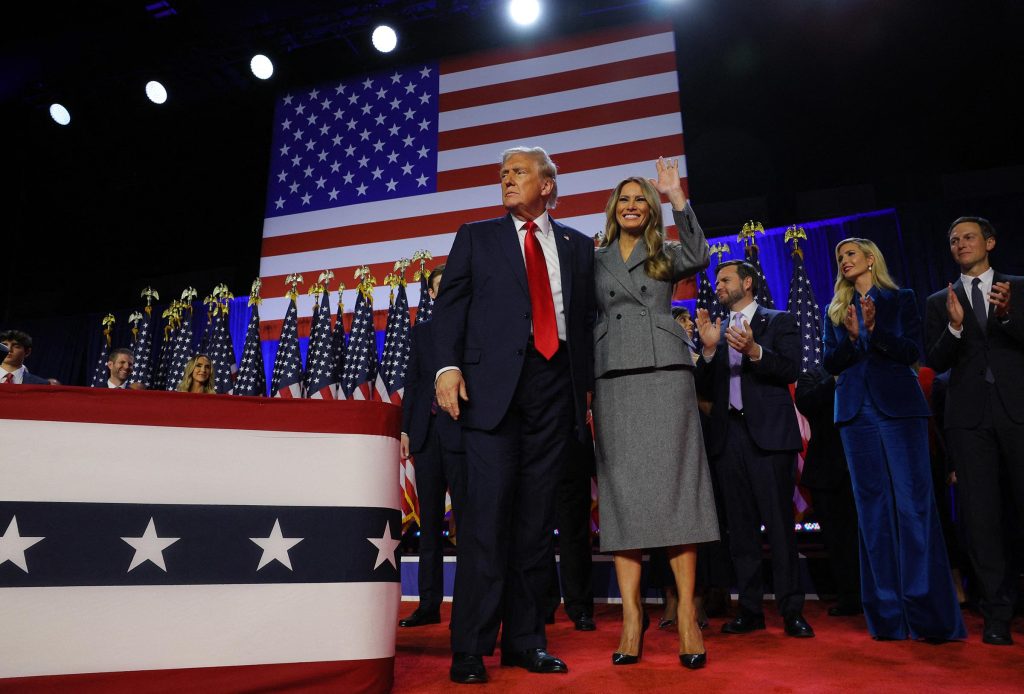Trump’s master plan for a radical reformation of the US government
4 min read
Republican presidential nominee, former U.S. President Donald Trump points to supporters with former first lady Melania Trump during an election night event, Nov.6, 2024, in West Palm Beach, Florida. Chip Somodevilla/Getty Images
The article outlines President-elect Donald Trump’s ambitious plans for his second term, with a particular focus on radical reforms aimed at reshaping the U.S. government. These reforms range from aggressive immigration policies to expansive cuts in government spending, and they promise to have a profound effect on the country’s political, economic, and social landscape.
Key Points of Trump’s “Master Plan”:
- Mass Deportation of Undocumented Immigrants: Trump has reiterated his commitment to mass deportation, aiming to remove millions of undocumented immigrants from the country. This will likely involve using executive orders to reverse policies implemented by the Biden administration, including the expansion of border enforcement. The logistics of such a large-scale operation remain unclear, though it’s expected to begin on Trump’s first day in office, according to his advisor Stephen Miller.
- Closing the Southern Border and Ending Birthright Citizenship: Trump has promised to close the southern border entirely and eliminate birthright citizenship for the children of undocumented immigrants. This would require a significant legal battle, as the 14th Amendment guarantees birthright citizenship, which could lead to immediate challenges in the courts.
- Economic Policies and Tax Cuts: Trump aims to enact expansive tax cuts, particularly benefiting corporations, seniors on Social Security, property owners, and tipped workers. He also plans to implement tariffs on foreign goods, especially from China, which he believes would help revitalize the U.S. economy. These measures could face resistance both domestically and internationally.
- Government Spending Cuts: Trump has promised to make significant cuts to government spending, aided by private sector figures like Elon Musk. This could involve downsizing government programs and drastically reducing the size of the federal bureaucracy.
- Reforming Health and Food Systems: Trump’s health reform agenda is set to include figures like vaccine skeptic Robert F. Kennedy Jr., signaling a shift away from the current approach to health policy. This may also include reforms to the U.S. food system.
- Climate Change Regulations: A key part of Trump’s plan includes reversing environmental regulations aimed at addressing climate change. He’s expected to continue rolling back environmental protections to align with the interests of businesses and energy sectors.
- Building a Missile Defense Shield: Trump has pledged to build a new missile defense shield, with assistance from people like former NFL player Herschel Walker. This would likely involve extensive investment in defense infrastructure.
- Aggressive Government Overhaul: Trump has laid out plans to overhaul the federal government, including eliminating “rogue bureaucrats” and shifting federal agencies away from Washington, D.C. His push to reclassify much of the federal workforce through a “Schedule F” plan aims to make it easier to fire civil servants who don’t align with his administration’s goals.
- Tackling Congressional Oversight: Trump has signaled his intention to challenge the legislative powers of Congress, particularly in terms of government spending. His desire to assert executive control over the budget and challenge existing laws limiting presidential power over spending could lead to a showdown with Congress.
- Cabinet Appointments: Trump’s cabinet will likely include loyalists, many of whom are associated with Project 2025, a comprehensive conservative plan for restructuring the federal government. However, confirming these officials will require Senate approval, which may face challenges, especially with a potentially slim Republican majority.
- Taking Power Away from Congress: One of Trump’s less publicized proposals is his desire to limit Congressional control over government spending. He has expressed interest in reasserting “impoundment” power, allowing the president to reject Congressional spending mandates and reallocate taxpayer money according to his priorities.
Implementation and Challenges:
While Trump’s agenda is bold and comprehensive, much of it faces significant hurdles. Legal challenges, resistance from Congress, and potential pushback from the courts could stall or derail many of his proposals. The 14th Amendment and Supreme Court precedents would pose major barriers to efforts to end birthright citizenship, while implementing mass deportations could be logistically complicated and expensive. Moreover, Trump’s attempts to consolidate power within the executive branch may lead to further conflicts with the legislative and judicial branches.
Conclusion:
Trump’s second-term agenda promises significant upheaval in U.S. governance, especially in the areas of immigration, the economy, and government structure. Whether these plans will come to fruition largely depends on his ability to overcome legal challenges, secure support from Congress, and effectively implement his vision within the framework of the Constitution. With key allies in place, including figures from Project 2025, Trump is preparing to push for these radical changes, but how much of this will be achievable remains uncertain.







